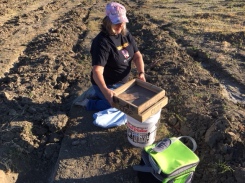ToadDate 0379.10.12.17-AR
The diamond is the state gem of Arkansas. In Murfreesboro, Arkansas is the Crater of Diamonds State Park. This is the only place in the world where you can dig for diamonds and keep all you find. The digging field is 37 acres with washing stations and a place you can rent all the equipment you need to find diamonds. An ancient volcano crater is the home to the digging field. There are shovel markers throughout the field showing the locations of some of the most significant diamonds found. Diamonds found here are jewel quality and are white, yellow, and brown. This is the 8th largest diamond reserve in the world.
The state created this park in 1972 but diamonds have been mined here since 1906. Since it has been a state park over 32,000 diamonds have been found (average of 2 diamonds per day are found.) The largest one was found in 1924, 40.23 carats, named the Uncle Sam. On July 31, 2013, 12-year-old Michael Dettlaff discovered Crater of Diamonds State Park’s 27th largest diamond, a 5.16 carat honey-brown diamond. He found the diamond within minutes of arrival, before his father had rented their mining equipment. In May 2017, a teenager found a 7-carat diamond while walking across the digging field.
With all this buildup of finding diamonds, we set out. First stop was to rent the diamond screen sets for sifting the diamonds from the soil (we had our own bucket and shovel). You need two screens, one with a larger mesh to sort out the largest rocks and the second one is a much finer mesh screen to capture the smaller stones. You stack the screens together (large mesh on top of the smaller mesh), dump a spade full of soil in the boxes, and then shake to sift the stone out of the soil. Most diamonds are found in the finer mesh box, so you really need to check out the stones that end up in this box.
Other way (and my preferred way) is to wet sift. Take the boxes and a bucket full of soil to the washing stations. Stack the two boxes, put a shovel full of soil (you can process more at time this way). Then lower the stacked boxes into the water and wash away the soil to see the stones. Once the soil is washed off, take the larger screened box out of the water, and set it aside. Now you have the finer mesh box full of dirt and gravel. Wash off the dirt, then swirl the box with the remaining gravel and stones. Turn the box over on the table and look in the center of the pile of gravel. The heaviest stones will be in the center, that’s where the diamonds are found, since they are very heavy for their size.
There was a man, from Mountain View, MO, working at the same washing station that we were who visits about 10 days a month to dig for diamonds. He averages one diamond a day and processes more than ten 5-gallon buckets of soil per day. He had lots of stories to tell and was willing to offer advice. Before we left he gave us an agate that he had found that day. It is about the size of my hand.
Results of our 5 hours of digging and approximately 5 buckets of soil: calcite, quartz, jasper, and tuff (volcano ash) – no diamonds. We had fun, but it would have been great to have found a diamond.
The diamond mine isn’t the only thing to do in this park. There are trails to hike, beautiful campsites shaded with large trees for relaxing, and a water park open in the summer months (closed now). We recommend checking out this park and if you find a diamond consider it a bonus. The young man who found the 5.16 carat diamond in 2013, Michael, and his family were traveling from their home in Apex, North Carolina to visit relatives in Fayetteville, Arkansas when they drove 100 miles out of their way to visit the Crater of Diamonds State Park. It could be worth your time to make the trip.





The diamond in Marilyn’s wedding ring came out when we were building Katie and Johnny a sandbox. Found it!! Same system.Peace.
LikeLike